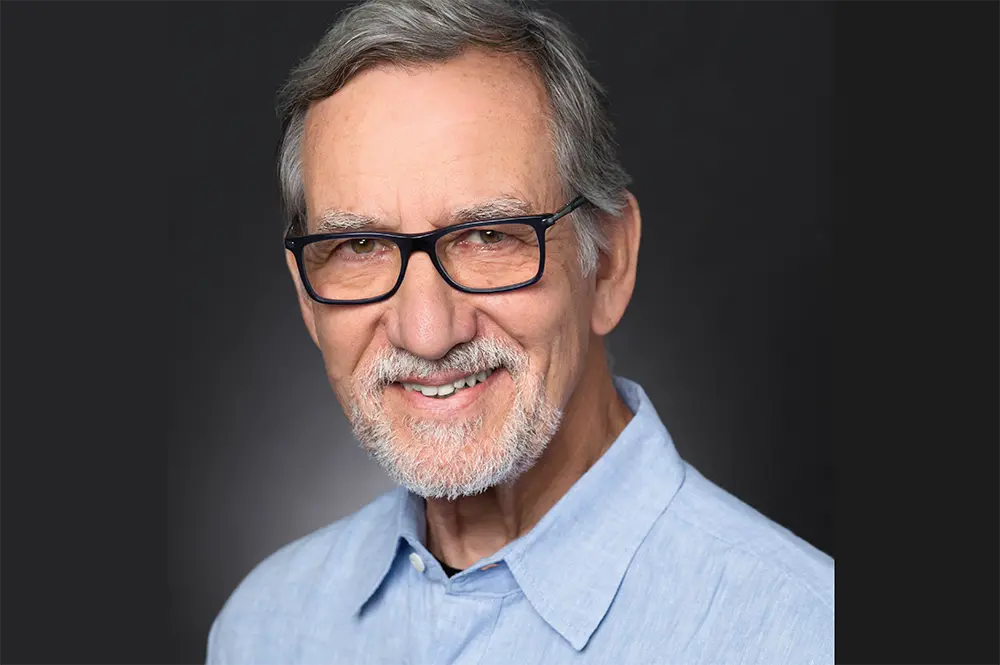
The room was packed with a standing-room-only crowd. The year was 1963, and the setting was Woods Hole, Massachusetts, renowned for its summer classes in biology. James Spudich (BS, ‘63, chemistry) had just finished his bachelor’s degree at the University of Illinois, and he stood at the front of the room, wiping the blackboard in preparation for the next speaker—U of I biochemist Woody Hastings.
But as Hastings stepped up to the lectern, the professor suddenly threw a curve ball to the crowd. He introduced his young student, Spudich, who strolled up to the podium and began giving the lecture, in Hasting’s place, to the shocked audience.
“Nobody was expecting it,” Spudich recalled. Only he and Hastings knew the secret, and the crowd responded enthusiastically.
Spudich has also gone on to become one of the most respected biochemists in the world. He credits his two years in Hastings’ lab at U of I and two summers in Woods Hole, where Hastings headed the physiology course, as the sparks that sent him from chemistry to biochemistry.
Spudich has made his mark with pioneering discoveries on molecular motors—the tiny powerhouses responsible for movement at the cellular level. For this research, he has won a 2016 Alumni Achievement Award—one in a long line of honors. He also won the prestigious Albert Lasker Basic Medical Research Award in 2012, an impressive honor as evidenced by the fact that almost half the Lasker awardees subsequently won a Nobel Prize.
His two years in Woody Hasting’s U of I laboratory was the first turning point in his career, followed by superb training in biochemistry and genetics at Stanford. Another turning point came during postdoctoral research in structural biology at Cambridge University in England. He worked with Hugh Huxley on muscle
research from 1969 to 1971, setting him on the path of studying molecular motors.
Molecular motors are like microscopic automobiles, running along tracks in our cells and burning fuel called ATP. In a human muscle, the motor is called myosin, and the track is called actin.
In his early research, Spudich and his colleagues purified out both myosin and actin and then coated microscope slides with the purified myosin molecules. Then, in 1986, Spudich and his PhD student, Steve Kron, proved that out of the 5,000 or so proteins in a cell, you only needed these two proteins—actin and myosin—to create movement that was the equivalent of a muscle contraction.
“This was a huge breakthrough because it simplified what you needed to understand about how that movement was occurring,” he said.
Today, scientists around the world who study molecular motors use the assay that he and his students developed from this research.
In another breakthrough, in 1994, Spudich’s team lowered a single actin filament onto a single myosin molecule, so they could watch what happens when one myosin molecule interacts with one actin. This helped open up a field of biology now called “single molecule biology.” To do this work, Spudich’s team built a laser trap with the help of Steve Chu, a Stanford physicist who won a Nobel Prize in 1997 for trapping atoms. (Chu also served as the Secretary of Energy from 2009 to 2013.)
The collaboration between Spudich and Chu was unique. Spudich had his team work part of the time for a year or more in Chu’s physics lab, while Chu’s physics students spent some of their time for several years in Spudich’s lab learning biochemistry.
This student-swapping collaboration inspired Spudich and Chu to bring a new idea to Condoleezza Rice, the former Secretary of State who was then Stanford’s provost. They suggested to her the creation of a program that would bring together talent from physics, biology, chemistry, engineering, computational sciences, and the clinical sciences. They called it Bio-X. Spudich served as its first director from 1998 to 2001, and today over 600 faculty members across campus are part of the Bio-X program.
Spudich also started his first company in 1998, developing a drug that makes the healthy part of a damaged heart work harder so that overall heart function remains the same. A second drug aims to improve muscle function for patients with ALS, or Lou Gehrig’s disease. Both are in late stage clinical trials. Meanwhile, a second company, started in 2012, is developing a drug that slows down a racing heart in patients with a mutation that causes their heart muscle to overwork.
As for Spudich, he shows no signs of slowing down. But whenever he wants a break from this hectic pace, he goes to the air. He has been flying small planes for more than 40 years, and he even wrote a book on flying.
“You’re 1,000 feet above the ground and suddenly your whole perspective changes,” he said. “You realize there are all kinds of things going on down there, and it puts perspective on the things we spend all of our time worrying about. As Antoine de Saint-Exupéry expressed it, ‘I fly because it releases my mind from the tyranny of petty things.’”